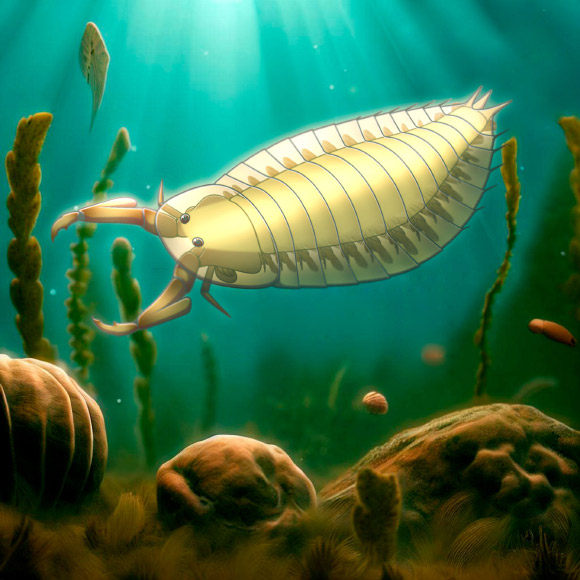The Waukesha Biota, a 437-million-year-old fossil assemblage from Wisconsin, USA, provides a rare glimpse into life in an ancient lagoon. In his book Wonderful Life Stephen Jay Gould (1989) compared the range of form of Cambrian animals in the Burgess Shale with only five other fossil sites in the world; one of them was at Waukesha.
Spectacular new fossils from the Waukesha Biota have been revealed for the first time.
Venustulus was about 7 cm long with a semi-circular carapace, bearing appendages, a short ten-segmented body and a tail spine.
It belongs to an extinct group of arthropods (animals with an exoskeleton and jointed limbs) called synziphosurines, related to living horseshoe crabs, united with arachnids and the giant (up to 2.5 m long) extinct sea scorpions (eurypterids) in a broader group called chelicerates that have claw-like front appendages.
Acheronauta was about 6 cm long with a large carapace that covered raptorial (prey-capturing) appendages, and a long multi-segmented trunk bearing swimming appendages.
It may relate to a rare group of crustacean-like arthropods called thylacocephalans, also known from this biota.
They also occur with a mysterious unnamed arthropod known only as the ‘butterfly animal.’
Parioscorpio was about 5 cm long, with large raptorial appendages, like those of the living giant water bug, and a flat, oval-shaped body.
It was initially interpreted as the oldest scorpion, but is probably related to a rare group of arthropods called cheloniellids.
These ancient animals lived during the Early Silurian period, 437 million years ago.
The fossils were found in the Brandon Bridge Formation near Milwaukee, Wisconsin, in finely laminated, fine-grained mudstones, deposited in a tidal shallow marine lagoon.
Microbial mats (cyanobacteria), algae, sponges, conulariids (possibly related to jellyfish), graptolites, worms (polychaetes and palaeoscolecids), an orthocone nautiloid, a rare conodont animal (only the second complete example of this lamprey-like animal in the world) and a lobopodian also occur.
A dozen types of trilobites, including some new species, and crustaceans (phyllocarids and ostracodes) are quite common.
The exceptional preservation of the fossils was helped by the tidal conditions and/or microbial mats.
Soft tissues (limbs, eyes and guts) are preserved in some of the arthropods, lobopodian and conodont.
“These fossils are important because they reveal so much about the soft-bodied animals of the Silurian period,” said Kenneth Gass, from the Milwaukee Public Museum, lead author of the study.
The article appears in the Geology Today.
_____
K.C. Gass & S.J. Braddy. 2023. The Waukesha Biota: A wonderful window into early Silurian life. Geology Today 39 (5): 169-175; doi: 10.1111/gto.12447










